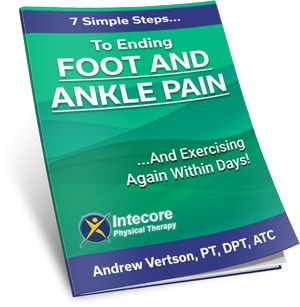
What’s the difference between sciatica and piriformis syndrome? Have you ever experienced a nagging pain in your lower back or buttocks that radiates down your leg?
It’s easy to jump to conclusions and label any shooting leg pain as sciatica. However, there’s a lesser-known culprit that could be at play—piriformis syndrome. Both conditions can cause a similar type of pain, but they stem from different sources. In this blog, we’ll unravel the mystery behind these two conditions, helping you distinguish one from the other so you can take the first step toward alleviating that pesky pain.
More Posts Like This By Intecore:
Experience Lasting Relief: 5 Proven Strategies for Lower Back and Hip Pain
How To Sleep with Sciatica and Back Pain
Top 5 Common Posture Problems and How To Fix Them
Table of Contents
What is Sciatica?
Sciatica refers to pain that radiates along the path of the sciatic nerve, which branches from your lower back through your hips and buttocks and down each leg. Typically, sciatica affects only one side of your body. It’s not a condition in itself but a symptom of an underlying issue, such as a herniated disk or spinal stenosis, that puts pressure on or irritates the nerve.
Causes and Symptoms
The primary cause of sciatica is a herniated disk or bone spur on the spine compressing part of the sciatic nerve. This compression causes inflammation, pain, and often some numbness in the affected leg. Pain that radiates from the lower (lumbar) spine to your buttock and down the back of your leg is the hallmark of sciatica. You might feel discomfort almost anywhere along the nerve pathway, but it’s especially likely to follow a path from your low back to your buttock and the back of your thigh and calf. The pain can vary widely, from a mild ache to a sharp, burning sensation or excruciating discomfort. Sometimes it can feel like a jolt or electric shock. Sciatica can also cause numbness, tingling, or muscle weakness in the affected leg or foot.
What is Piriformis Syndrome?
Piriformis syndrome is a neuromuscular disorder that occurs when the piriformis muscle—a small muscle located deep in the buttock, behind the gluteus maximus—compresses or irritates the sciatic nerve. Unlike sciatica, which is caused by spinal issues, piriformis syndrome arises from problems within the muscle itself, often related to muscle spasms, swelling, or tightness.
Causes and Symptoms
Piriformis syndrome can be caused by overuse, injury, or sitting for long periods. Symptoms are similar to sciatica and include pain, tingling, or numbness in the buttocks and along the path of the sciatic nerve down the leg. However, the pain is usually more localized to the buttock and hip area rather than the broader pathway seen in sciatica. Patients might also experience discomfort when sitting or with activities that cause the piriformis muscle to press against the sciatic nerve, such as running or sitting with crossed legs. The pain may increase with changes in position or physical activity and improve with rest.
Key Difference Between Sciatica and Piriformis Syndrome
- Origin of Pain:
- Sciatica: Originates from issues in the lower back, such as herniated discs or spinal stenosis, affecting the sciatic nerve.
- Piriformis Syndrome: Originates from the piriformis muscle in the buttocks, which irritates or compresses the sciatic nerve.
- Symptom Location:
- Sciatica: Pain radiates from the lower back through the buttock down to the leg and foot.
- Piriformis Syndrome: Pain is primarily in the buttocks and may radiate to the leg, typically not beyond the knee.
- Cause of Condition:
- Sciatica: Caused by spinal issues like herniated disks, bone spurs, or spinal narrowing.
- Piriformis Syndrome: Caused by overuse, injury, or prolonged sitting leading to piriformis muscle spasms or tightness.
- Nature of Pain:
- Sciatica: Can range from a mild ache to a sharp, burning sensation or severe discomfort; may feel like an electric shock.
- Piriformis Syndrome: Often presents as a deep ache in the buttock, with pain sometimes worsening when sitting or during activities that put pressure on the piriformis muscle.
- Treatment Focus:
- Sciatica: Treatment may include physical therapy, medications, and sometimes surgery to address the underlying spinal issue.
- Piriformis Syndrome: Treatment often focuses on relieving muscle tension through physical therapy, stretches, and massage; may also include medication to reduce inflammation.
Diagnosis and Treatment
Diagnosing and treating conditions like sciatica and piriformis syndrome require a comprehensive approach to ensure the right strategies are applied for relief and recovery.
Physical Therapy Evaluation
Initial Assessment: A physical therapist will begin with a thorough evaluation, which includes a detailed history of your symptoms, physical activities, and any recent injuries. They’ll perform a physical examination to assess your posture, flexibility, and the range of motion of your spine and legs.
Diagnostic Tests: While physical therapists do not perform imaging tests, they may recommend you to a specialist for X-rays, MRI, or CT scans if your history and initial assessment indicate a need. These imaging tests help to rule out other causes of your pain and confirm the diagnosis of sciatica or piriformis syndrome.
Movement Analysis: Your therapist will observe your movements to identify pain triggers and assess how your pain affects your ability to perform daily activities. They might also use specific tests to stretch the piriformis muscle or replicate the pain to differentiate between sciatica and piriformis syndrome.
Treatment Options
For Sciatica:
- Exercise Therapy: Tailored exercises to strengthen the muscles supporting your spine, improve flexibility, and decrease pressure on the sciatic nerve.
- Manual Therapy: Hands-on techniques to mobilize the spine, reduce muscle tension, and alleviate nerve compression.
- Education: Advice on posture and ergonomics to avoid activities that trigger pain, alongside strategies to manage symptoms at home.
For Piriformis Syndrome:
- Stretching Exercises: Focus on stretching the piriformis and surrounding muscles to relieve muscle tightness and reduce pressure on the sciatic nerve.
- Massage and Manual Therapy: Techniques to release muscle knots and improve blood flow to the affected area.
- Heat or Cold Therapy: Application of heat can relax tight muscles, whereas cold therapy may reduce inflammation and pain.
Common to Both Conditions:
- Pain Management: Use of modalities like TENS (Transcutaneous Electrical Nerve Stimulation) or ultrasound to manage pain.
- Activity Modification: Guidance on modifying activities that exacerbate the condition, promoting a balance between rest and activity to facilitate healing.
Ultimately, the goal of physical therapy is not only to alleviate the immediate symptoms but also to equip patients with the tools and knowledge to prevent future episodes, ensuring long-term well-being.
Ready To Get Help With Physical Therapy?
If you’re tired of living with back pain, physical therapy might be the solution you’ve been searching for. We can work with you to provide specialized exercises, hands-on therapy, and tailored advice to help alleviate the pain long-term and get you back to doing the things you enjoy.
To find out more, click here to fill out a quick form and tell us what’s going on and our team will be in touch. Or, you can give us a call: (949) 569-5847
- What Is Gout? Why It Happens and What You Can Do About It - November 17, 2025
- 3 Essential Back-Saving Tips You MUST Know Before Any Workout - November 14, 2025
- Are You Experiencing Shoulder Pain from Sleeping Wrong? - October 21, 2025













